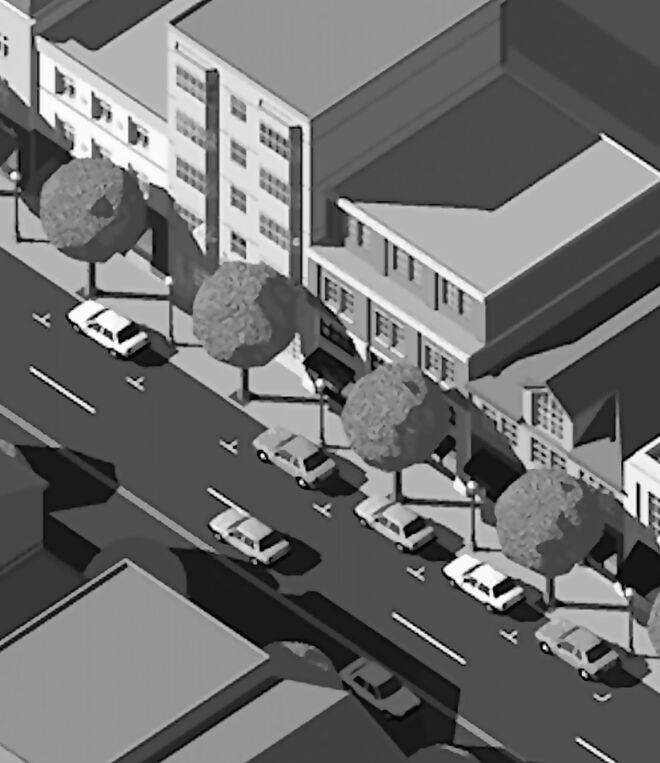16.1. Form-Based Code
Aus Pattern Language Wiki
In order to make a Walkable Streetscape with Street As Room and other cohesive elements, it is necessary to have a framework.
Problem-statement: There is a need to guide the form of buildings so that the results are cohesive and supportive of the public realm. But too many zoning codes destroy the diversity and richness of the built environment.
Discussion:In the 20th century, a generation of zoning codes came into widespread use that segregated buildings into zones based upon their use. Residences of a certain kind were to go into one area, while other areas contained only residences of another kind, while other areas contained only retail, or workplaces, or civic districts, or other single uses. The result was that each area became a “monoculture” — a dead area, lacking diversity, interaction and dynamism.
To make matters worse, those zoning codes said little about how forms might work cohesively to support the public realm. They might require large setbacks from the street, or large lots — which only further damaged the vitality of the neighborhood. But these codes did not address the characteristics needed to define and support the public realm: enclosure, connection, visibility, pedestrian detail and so on. This practice is one of the key reasons that the public realm has disintegrated in too many cities.
More recently, a form of urban code has become common that is based on form rather than use. Typically the code specifies the siting of buildings, their length of frontage, their volume, number and placement of doors and windows, and so on. Minimal regulations are placed on use, mainly to mitigate negative impacts from noise, odors and other problems.
At the same time, it is important to avoid a too-mechanical, “cookie-cutter” approach to codes. Some guidance is also needed to assure a locally distinctive, cohesive result without becoming too monotonous or restrictive. There are a number of design guidelines, preferred materials and details, and other elements that can be added to a form-based code. Indeed, the pattern language approach itself is a way of providing guidance and cohesion while maintaining the natural flexibility of language.
Therefore:
At either the project scale or neighborhood scale, develop a form-based code to guide the design and assure a cohesive support of the public realm. Regulate the form of buildings at the edges, and also provide flexible guidance on elements like materials, colors and details.
Assure that the code takes into account local conditions and adaptations with Economies Of Place And Differentiation. …
¹ See Talen, E. (2009). Design by the rules: The historical underpinnings of form-based codes. Journal of the American Planning Association, 75(2), 144-160.
Mehaffy, M. et al. (2020). FORM-BASED CODE (pattern). In A New Pattern Language for Growing Regions. The Dalles: Sustasis Press. Available at https://pattern-language.wiki/.../Form-Based_Code
SECTION I:
PATTERNS OF SCALE
1. REGIONAL PATTERNS
Define the large-scale spatial organization…
1.4. 400M THROUGH STREET NETWORK
2. URBAN PATTERNS
Establish essential urban characteristics…
3. STREET PATTERNS
Identify and allocate street types…
4. NEIGHBORHOOD PATTERNS
Define neighborhood-scale elements…
5. SPECIAL USE PATTERNS
Integrate unique urban elements with care…
6. PUBLIC SPACE PATTERNS
Establish the character of the crucial public realm…
7. BLOCK AND PLOT PATTERNS
Lay out the detailed structure of property lines…
8. STREETSCAPE PATTERNS
Configure the street as a welcoming place…
9. BUILDING PATTERNS
Lay out appropriate urban buildings…
10. BUILDING EDGE PATTERNS
Create interior and exterior connectivity…
10.1. INDOOR-OUTDOOR AMBIGUITY
SECTION II:
PATTERNS OF MULTIPLE SCALE
11. GEOMETRIC PATTERNS
Build in coherent geometries at all scales…
11.2. SMALL GROUPS OF ELEMENTS
12. AFFORDANCE PATTERNS
Build in user capacity to shape the environment…
13. RETROFIT PATTERNS
Revitalize and improve existing urban assets …
14. INFORMAL GROWTH PATTERNS
Accommodate “bottom-up” urban growth…
15. CONSTRUCTION PATTERNS
Use the building process to enrich the result…
SECTION III:
PATTERNS OF PROCESS
16. IMPLEMENTATION TOOL PATTERNS
Use tools to achieve successful results…
16.2. ENTITLEMENT STREAMLINING
16.3. NEIGHBORHOOD PLANNING CENTER
17. PROJECT ECONOMICS PATTERNS
Create flows of money that support urban quality…
17.4. ECONOMIES OF PLACE AND DIFFERENTIATION
18. PLACE GOVERNANCE PATTERNS
Processes for making and managing places…
18.3. PUBLIC-PRIVATE PLACE MANAGEMENT
19. AFFORDABILITY PATTERNS
Build in affordability for all incomes…
19.1. INTEGRATED AFFORDABILITY
20. NEW TECHNOLOGY PATTERNS
Integrate new systems without damaging old ones…
20.2. RESPONSIVE TRANSPORTATION NETWORK COMPANY


